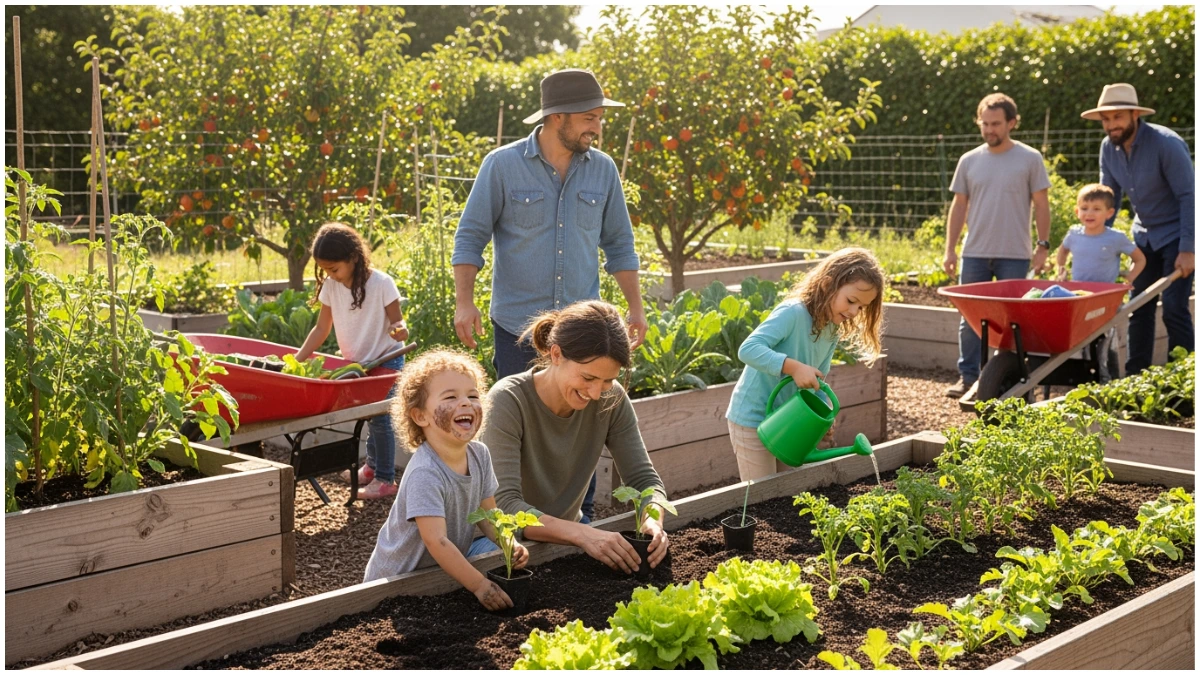Bringing a child into the world changes not just your daily routines but your entire perspective on the future. As parents and caregivers, we naturally want to provide the very best for our children, yet increasingly, many of us are recognizing that what’s best for our little ones is intrinsically connected to what’s best for the planet they’ll inherit. Eco-friendly parenting represents this growing awareness—a thoughtful approach to raising children that considers environmental impact alongside health, happiness, and well-being.
I’m Katrina, and I’m thrilled to welcome you to this exploration of sustainable family living. Whether you’re expecting your first child, already knee-deep in nappy changes, or simply curious about how to reduce your family’s environmental footprint, this guide is designed to meet you wherever you are on your journey. The wonderful thing about eco-friendly parenting is that it doesn’t demand perfection—it simply invites us to make conscious choices, one step at a time, that benefit both our families and the world around us. Let’s discover together how small changes can create meaningful impact for generations to come.
Understanding the Foundations of Green Parenting
A philosophy rooted in care: At its heart, eco-friendly parenting is about raising children in a way that respects both their immediate well-being and the long-term health of the planet. This approach extends beyond recycling—it encompasses a holistic lifestyle that integrates sustainability into every aspect of family life, from the food you eat to the toys your children play with. Green parenting recognizes that the choices we make today shape the world our children will inhabit tomorrow.
More than a trend: While sustainable parenting has gained significant momentum in recent years, it’s far more than a passing fad. Parents across the globe are increasingly aware of their environmental impact and are prioritizing eco-friendly choices when shopping for their little ones. This encompasses everything from using eco-friendly nappies and baby products to choosing sustainable clothing, toys, and educational resources. The movement reflects a fundamental shift in how families think about consumption, waste, and their relationship with the natural world.
The legacy we leave: Becoming a parent often triggers a heightened awareness of long-term risks, a concept researchers refer to as the “legacy hypothesis.” When you hold your newborn, the abstract concept of climate change suddenly becomes deeply personal. This new perspective inspires many parents to examine their daily habits and make changes that protect their child’s future. By adopting eco-friendly practices, you’re reducing your household’s environmental footprint while modelling values of responsibility, mindfulness, and stewardship that your children will carry throughout their lives.

Understanding these foundations naturally leads us to one of the most significant decisions new parents face—the nappy dilemma and other baby product choices that can dramatically affect your family’s environmental impact.
The Nappy Dilemma and Sustainable Baby Products
A staggering scale of waste: One of the most eye-opening statistics in sustainable parenting concerns disposable nappies. In the United States alone, an estimated around 20 billion disposable diapers are sent to landfill each year, creating about 3.5 million tons of waste per year. Globally, estimates suggest billions of disposable nappies and diapers are discarded every year, contributing substantially to plastic waste and landfill volumes. In Australia and New Zealand, about 3.75 million disposable nappies are used each day, with roughly one cup of crude oil required to manufacture each nappy.
The decomposition reality: Perhaps most concerning is how long these products persist in our environment. According to the Environmental Protection Agency, disposable nappies can take up to 450 years to decompose in a landfill environment—meaning every disposable nappy ever created that hasn’t been incinerated still exists somewhere on our planet, breaking down extremely slowly. The materials used to manufacture disposable diapers—including plastic, wood pulp, and absorbent gels—do not readily decompose, meaning they can persist in landfills for centuries. The UK’s Department for Environment, Food and Rural Affairs (DEFRA) acknowledges that the environmental impact of disposing of a single-use nappy is nine times higher than that of a reusable nappy.
The cloth alternative: Modern cloth nappies have evolved dramatically from the terry toweling and safety pins of previous generations. Today’s reusable options are functional, attractive, and far more convenient than many parents expect. Cloth nappies are made from renewable plant sources such as cotton, bamboo, and hemp, whereas disposables rely on non-renewable resources. By choosing cloth nappies over disposables, families can divert over 8,000 nappies from landfill and essentially reduce single-use plastic consumption by 99%. While cloth nappies require more water for washing, the production and cleaning of cloth nappies combined uses approximately the same amount of water as the production of disposables—yet disposables use more energy and land in their production and create about 20 times more solid waste.
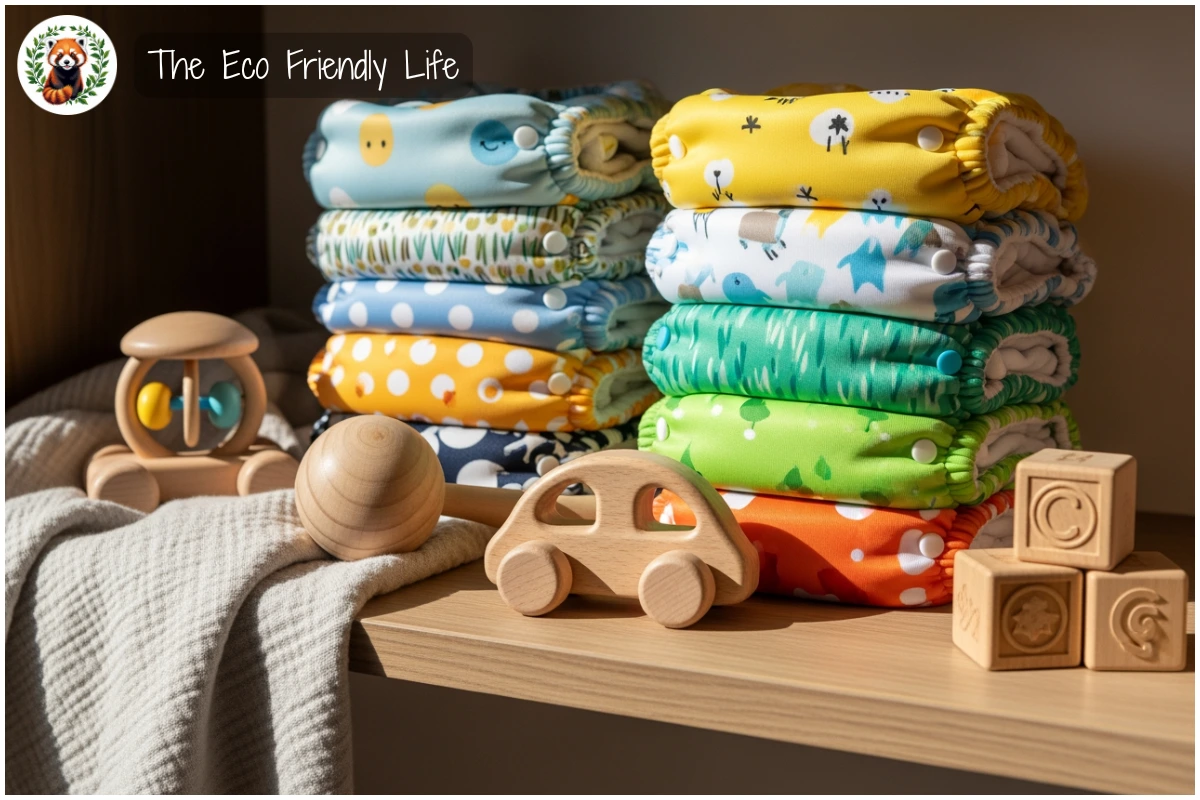
Beyond nappies: Sustainable baby products extend well beyond what goes on your little one’s bottom. Parents are increasingly opting for organic cotton clothing, wooden toys, and other natural materials that are safe for both babies and the environment. Many families are choosing eco-friendly, biodegradable wipes to reduce their carbon footprint. Glass or stainless-steel bottles offer sustainable alternatives to plastic, while bamboo plates and utensils provide safe, chemical-free feeding options. When it comes to the nursery, non-toxic paints, sustainable flooring materials, and furniture made from renewable resources create a healthier space for baby to grow.
Of course, the products we choose are just one aspect of eco-friendly parenting. Equally important is how we teach our children to understand, respect, and care for the natural world—something we’ll address in the next section.
Nurturing Environmental Awareness in Children
Raising children who understand and care about the environment doesn’t require elaborate programs or expensive equipment. The most powerful environmental education happens through everyday moments, meaningful conversations, and the consistent example we set as parents and caregivers.
Leading by example: Children learn by observing the behavior of adults around them, making us their most influential environmental teachers. When children see their parents recycling, conserving water and energy, and choosing eco-friendly products, these practices become normalized parts of daily life. Your actions speak louder than any lecture—whether it’s carrying reusable bags to the shops, composting kitchen scraps, or choosing to walk instead of drive for short trips. Remember that children are remarkably observant; they notice when you make environmentally conscious choices and absorb these values naturally.
Connecting with nature: Encouraging children to develop a connection with nature is perhaps the single most important thing we can do to raise environmentally conscious individuals. Whether it’s hiking through bush-land, gardening in the backyard, or simply taking a walk in the local park, immersing children in natural environments cultivates appreciation for the Earth’s beauty and reinforces the importance of preserving it. The Children & Nature Network’s research consistently shows that spending time in nature enhances educational outcomes, improves children’s academic performance, focus and behavior, and inspires love of learning. Children who are connected to nature demonstrate better health outcomes, higher satisfaction with life, and pro-environmental behaviors.
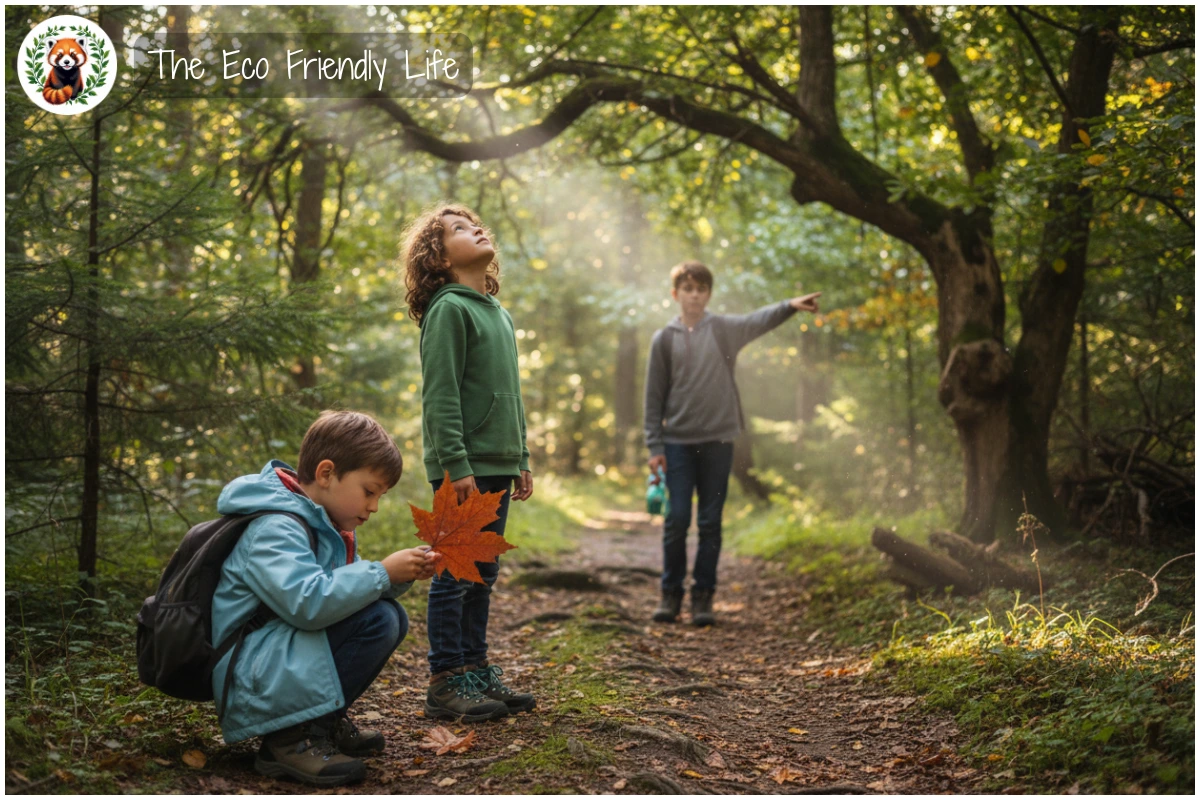
Making it fun and hands-on: Turn environmental practices into engaging activities rather than chores. Recycling can become a sorting game where children become “recycling heroes” saving the planet one container at a time. Composting with worms offers an irresistible combination of science and sensory experience for curious young minds. Nature scavenger hunts, creating art from recycled materials, and planting seeds to watch them grow all turn sustainability into adventure. The key is to match activities to your child’s interests and developmental stage, making environmental awareness feel playful rather than obligatory.
Age-appropriate conversations: Start conversations about sustainability using language and concepts your child can understand. For younger children, this might mean explaining why we turn off lights or don’t waste water. Older children can engage with more complex topics such as climate change, biodiversity, and the environmental impact of consumer choices. Children’s books about protecting nature, reducing waste, and caring for animals provide excellent conversation starters. Films such as Wall-E and The Lorax offer engaging ways to introduce environmental themes and spark meaningful discussions.
These foundational principles become even more powerful when supported by products and resources specifically designed with sustainability in mind. Finding trustworthy retailers who share your environmental values can make eco-friendly parenting significantly more accessible and convenient—which brings us to some recommended options worth considering.
Retailers That Support the Planet — Our Product Recommendations
Choosing where to shop is itself an act of environmental stewardship. By supporting businesses committed to sustainability, we vote with our wallets for a greener future while finding products that align with our values. Here are two retailers that demonstrate exceptional commitment to both people and planet, offering products directly relevant to eco-friendly parenting.
Our Retailer Recommendation for Adults
EarthHero — Your One-Stop Sustainable Marketplace
EarthHero emerged from a genuine concern about the adverse effects of hyper-consumerism on the natural environment. Today, this pioneering sustainable marketplace offers thousands of eco-friendly products, all carefully evaluated using their rigorous 5-Pillar Sourcing Methodology that assesses materials, company responsibility, ownership, packaging, and give-back programmes. As a Certified B Corp, 1% for the Planet member, and Climate Neutral designated business, EarthHero makes sustainable shopping accessible for everyone who loves the planet. For eco-friendly parents, their Baby & Kids collection offers everything from the Flappy Nappy cloth diapers made with organic cotton inners to natural rubber pacifiers, bamboo feeding utensils, and organic cotton clothing—all vetted for safety and sustainability.
Our Retailer Recommendation for Kids/Families
Green Kid Crafts — Inspiring Tomorrow’s Environmental Leaders
Green Kid Crafts takes a uniquely hands-on approach to environmental education through their award-winning subscription boxes. Founded by environmental scientist and mother Penny Bauder, this female-founded company delivers monthly STEAM activity boxes (Science, Technology, Engineering, Arts, and Mathematics) designed to spark creativity while cultivating respect and love for the environment. Each box contains 4-6 educator-designed activities made from eco-friendly materials, featuring themes such as Ocean Science, Green Energy, Climate Change, and Arctic Science. Green Kid Crafts is certified carbon neutral, Green America Approved, and plants one tree with every order through their partnership with One Tree Planted. Their Discovery Boxes for ages 5-10+ provide an excellent way to engage children with sustainability concepts through creative, nature-based learning—making it an ideal complement to any eco-conscious family’s toolkit.
These retailers represent the growing marketplace of sustainable options available to parents. But products alone don’t make an eco-friendly household—it’s the daily habits and routines practiced within your home that truly make the difference. Let’s examine how to create a sustainably-minded living environment that nurtures both your family and the planet.
Creating an Eco-Friendly Home Environment
Sustainable feeding practices: How we feed our babies and children offers numerous opportunities for environmental consciousness. Breastfeeding, when possible, represents one of the most eco-friendly feeding options, producing no waste and requiring no manufacturing, packaging, or transportation. Commercial milk formula has approximately twice the carbon footprint of breastfeeding. When bottle-feeding is necessary, glass or stainless-steel bottles offer durable, recyclable alternatives to plastic. As children transition to solid foods, making homemade baby food from locally sourced, organic ingredients reduces packaging waste while providing fresher, more nutritious meals. Stainless steel lunchboxes and silicone food pouches extend these sustainable practices as children grow.
The green nursery: Creating a sustainable nursery begins with thoughtful choices about furniture and materials. Opt for furniture made from sustainably-sourced timber, recycled materials, or pieces that can evolve with your child’s growth, serving multiple purposes over years. Seek out organic cotton bedding and blankets that offer breathability without harmful chemical treatments. Non-toxic, water-based paints ensure the air your baby breathes remains free of volatile organic compounds. GREENGUARD Gold certification indicates furniture and mattresses have been tested for over 10,000 chemical emissions and VOCs, meeting some of the world’s most stringent safety requirements. Natural light, good ventilation, and organic curtains complete a nursery that’s healthy for both baby and planet.
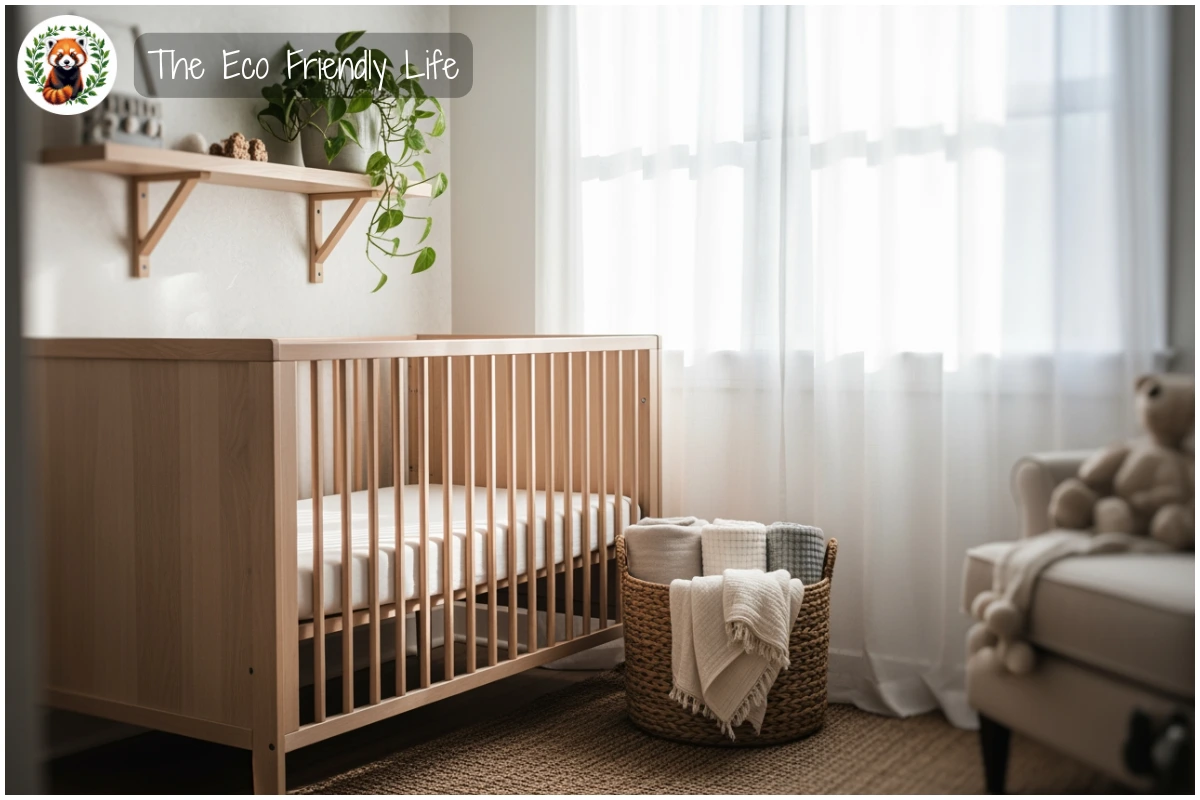
Reducing, reusing, and recycling: The classic environmental mantra applies powerfully to family life. Babies grow quickly, making secondhand items economically sensible and environmentally beneficial. Borrow what you can, share with other parents, and embrace hand-me-downs—this approach supports a circular parenting cycle that keeps perfectly good items in use rather than landfill. When purchasing new items, prioritize quality over quantity, choosing durable, multi-purpose items that will last through multiple children. Create clearly labelled recycling stations at child-height to involve even young family members in responsible waste management.
Energy and water consciousness: Small habits around the home accumulate into significant environmental savings. Teach children to turn off lights when leaving rooms, and explain in age-appropriate terms why electricity conservation matters. Washing clothes at 30°C (except for nappies and soiled items) saves energy while still achieving clean results. Line-drying nappies and clothes harnesses free solar energy while reducing electricity consumption. Low-flow taps and shorter showers model water conservation for children while reducing household usage.
Establishing these home-based practices creates a strong foundation for sustainable family living. But sometimes the most effective approach is having a clear, actionable list of changes you can implement immediately—practical steps that don’t require major investment or lifestyle upheaval. Here are some tips you can put into action starting today.
Practical Daily Tips You Can Action Today
Simple changes, consistently applied, create lasting environmental impact. The following table offers practical strategies you can begin implementing immediately, regardless of your family’s current stage or circumstances.
| Tip | How to Implement | How It Helps |
|---|---|---|
| Switch to reusable shopping bags | Keep fabric bags in your car, pram, and by the front door for easy access | Eliminates hundreds of single-use plastic bags annually from your household |
| Start a family compost | Begin with food scraps in a simple bin or worm farm; involve children in feeding and turning | Diverts organic waste from landfill while creating nutrient-rich soil for gardens |
| Choose secondhand first | Check op shops, marketplace apps, and parent swap groups before buying new | Extends product life-cycles and significantly reduces demand for new manufacturing |
| Establish a “lights off” routine | Create a fun family habit of checking lights before leaving home or going to bed | Reduces electricity consumption and associated carbon emissions |
| Pack waste-free lunches | Use reusable containers, beeswax wraps, and cloth napkins instead of disposable packaging | Eliminates daily single-use plastic and teaches children sustainable habits |
| Walk or cycle for short trips | Choose active transport for journeys under two kilometers when safe and practical | Reduces carbon emissions while promoting physical activity for the whole family |
| Grow something edible | Start with easy herbs in pots or a small vegetable patch; involve children in planting and harvesting | Provides fresh food without packaging while teaching children where food comes from |
| Use natural cleaning products | Replace chemical cleaners with vinegar, baking soda, and plant-based alternatives | Reduces toxic chemicals in your home and waterways |
| Establish toy rotation | Rather than buying new, rotate existing toys to maintain novelty and interest | Reduces consumption while helping children appreciate what they have |
| Support local and seasonal | Choose locally produced foods and products when available | Reduces transportation emissions and supports local economies |
These daily practices form the backbone of an eco-friendly household, but you may have questions about specific aspects of sustainable parenting—let’s address some of the most common ones.
FAQs
Is eco-friendly parenting more expensive than conventional approaches?
While some sustainable products have higher upfront costs, many eco-friendly choices actually save money over time—cloth nappies can save families hundreds of dollars compared to disposables, and buying secondhand reduces expenses significantly. Focus on changes that fit your budget, starting with free practices such as reducing energy use and refusing single-use items.
At what age should I start teaching my children about environmental responsibility?
Children can begin learning sustainable habits from their earliest years through observation and simple participation. Toddlers can help with recycling sorting and turning off lights, while school-aged children can engage with deeper concepts about why these actions matter.
How do I handle pressure from family members who don’t understand our eco-friendly choices?
Focus on the positive aspects—health benefits, cost savings, and quality time together—rather than being preachy about environmental issues. Lead by example and share successes; many relatives become more supportive once they see sustainable practices working well for your family.
What if I can’t do everything—is partial commitment still worthwhile?
Absolutely—eco-friendly parenting isn’t about perfection but about making conscious choices where you can. Every reusable nappy used, every walk taken instead of a drive, and every piece of plastic refused makes a genuine difference. Start with changes that feel manageable and build from there.
Organizations to Support — Our Recommendations
Supporting organizations working at scale amplifies your family’s environmental impact far beyond what individual actions alone can achieve.
- World Wildlife Fund (WWF) operates in almost 100 countries to protect and restore the natural world, working on everything from species conservation to habitat restoration and climate solutions. WWF’s work directly supports the healthy ecosystems our children will inherit, and you can make a donation to support their conservation mission through tax-deductible contributions that fund high-impact projects protecting endangered species and their habitats worldwide.
- Children & Nature Network specifically focuses on turning the trend of indoor childhood back outdoors, supporting leaders and communities working to ensure all children have access to nature in their daily lives. Their research library is the world’s largest collection of peer-reviewed literature on nature’s benefits for children; you can become a member or donate to help ensure all children live, learn, and grow with nature in their daily lives.
- One Tree Planted offers a simple, direct way to support global reforestation—every dollar donated plants one tree. Working across six continents, they restore forests affected by natural disasters while supporting biodiversity and local communities; you can plant trees through their donation page in regions where your family feels most connected, with options for one-time or monthly giving.
Each of these organizations offers different ways to contribute, from one-time donations to monthly giving and membership programs, allowing you to choose what works best for your family.
Resources and Further Reading
Deepening your understanding of eco-friendly parenting helps you choose wisely and find approaches that work best for your family.
- Environmental Working Group (EWG) maintains invaluable databases for parents wanting to make safer product choices. Their Healthy Living app provides instant access to ratings on over 250,000 food, cleaning, and personal care products, allowing you to scan barcodes and find safer alternatives while shopping. Their Skin Deep cosmetics database and consumer guides help families navigate product labels with confidence.
- Natural Start Alliance, an initiative of the North American Association for Environmental Education, provides comprehensive resources for nature-based early learning, including professional guidance, research on connecting children with nature, and tools for parents wanting to incorporate more outdoor education into their children’s lives.
- Australian Institute of Family Studies offers evidence-based resources including their guide on nature play and child well-being, which summarizes research on how different types of nature contact promote child development and provides practical considerations for families wanting to increase outdoor experiences.
These resources provide ongoing support as your family’s eco-friendly journey evolves, offering trusted information backed by research and expert guidance.
Our Related Articles
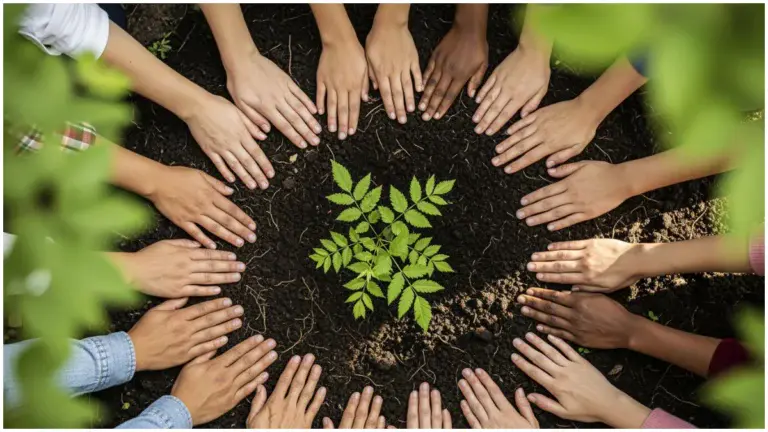
What Does It Mean To Live A Green Lifestyle?
Living a green lifestyle has moved from being a niche movement to a global necessity. As our planet faces unprecedented environmental challenges, from climate change…
Read More
What Is A Sustainable Home?
A sustainable home represents far more than an architectural trend or a collection of eco-friendly features. It’s a living space thoughtfully designed to minimize environmental…
Read MoreConclusion
Eco-friendly parenting represents one of the most meaningful commitments we can make as caregivers—a dedication to raising healthy, happy children while protecting the world they’ll inherit. From choosing cloth nappies over disposables to teaching children about nature through hands-on experiences, every conscious decision contributes to a more sustainable future. The journey doesn’t require perfection; it asks only for awareness, intention, and willingness to make changes where we can.
The environmental challenges facing our planet can feel overwhelming, but parenting offers unique opportunities for hope and action. Children raised with environmental awareness become adults who naturally consider their impact on the world. They carry sustainable habits into their own households and workplaces, creating ripple effects that extend far beyond what any single family could achieve alone. By embracing eco-friendly parenting, you’re reducing waste and conserving resources while raising the generation that will steward our planet through the coming decades.
What’s one sustainable change you’re ready to make in your family’s routine? Whether it’s starting cloth nappies, establishing a backyard compost, or simply spending more time outdoors with your children, share your thoughts and plans in the comments below. Your experience might inspire another parent taking their first steps on this important journey.


